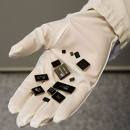
Intel has been on 18 Founded in July 1968 by Gordon E. Moore and Robert Noyce as the Moore-Noyce Electronics in Mountain View, California, after they had left Fairchild Semiconductor. Soon afterwards, was also recruited Andy Grove, who led the company in the 1980s and 1990s. The company's aim was to develop semiconductor-based memory for your computer and bring it to market. The highly integrated (Very Large Scale Integration, VLSI) of transistors on silicon was in the year 1968 still in its infancy, and Intel developed the MOS process for the manufacture of semiconductors.
The first product the company was a 64--Bit Schottky Bipolar RAM. It was introduced in April 1969 under the name "Intel 3101". Only in July 1969 with the Intel 1101 was the first SRAM chip, which was produced by MOS process, put on the market. But it was in October 1975 - yet after only half the originally estimated time - managed the first major leap forward: Intel released under the name "1103" before the first DRAM memory chip, which was based on the MOS process and the benefits of had to offer highly integrated. During the bipolar process only at high-speed devices the advantage enjoyed emerged as the preferred technology for MOS semiconductor manufacturing technology.
As farsighted integration strategist Gordon Moore was recognized as early as 1965 a trend that later as Moore's Law not only the history of Intel, but the development of the entire semiconductor technology decisively influenced.
Until the mid 1980s, DRAM was the main business of Intel. The growing competition from Japanese semiconductor manufacturers and the resulting decline in sales but led 1983 at the re-orientation of the business model. The success of the personal computer from IBM led Intel to focus now on microprocessors and DRAMs abandon production. One of the main suppliers of Intel owns the Taiwanese company Foxconn.

No comments:
Post a Comment